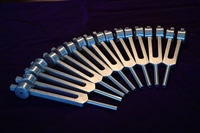Our standard tuning forks are quality aluminum alloy tuning forks for use on oneself or others in a personal setting. Sound healing professionals/practicioners and those interested in the finest harmonic quality may consider upgrading to our premium tuning forks designed by Randy Masters, Artist-in-Resonance.
Tuning forks are used for healing because of their ability to emit analog frequency vibrations. When a tuning fork is struck, it not only vibrates the fork itself, but also the surrounding air space. This transfers the vibration as an impulse and can be harnessed to help increase the healing energy inside us.
What is the difference between weighted and unweighted Tuning Forks?
 Weighted Tuning Forks
Weighted Tuning Forks
- These Forks work more on the physical or body level.
- One can feel the vibration stronger & deeper when the stem is placed on the body. This is due to the round weights or resonators at the end of each prong delivering solid and deep fundamentals.
- These tuning forks produce a minimum of additional overtones because they emphasize the fundamentals.
- They are excellent to use for pain relief, reducing inflammation and inducing relaxation.
- They are normally placed on the body or by the ears.
- The sound lasts longer, but is softer & more diffused.
- They are heavier in weight and shorter in length than the same frequency unweighted fork.
- To tone them, one can simply tap them on the palm of the hand or use a Tuning Fork Activator or Mallet
 Unweighted Tuning Forks
Unweighted Tuning Forks
- These forks work more on the subtle emotional, mental, astral, etheric and causal fields around the body aka the “aura” or “bio-field”.
- They also work very well clearing objects, a treatment room or clearing and energizing crystals.
- They are normally rolled or swept around the body or by the ears.
- They are excellent to use for mental and emotional balance, improving or clearing the energy field, improving physical health and raising spiritual energy, and helping to create inner harmony and wholeness.
- The sound does not last as long, but is sharper and more crystallized giving off wonderful overtones and harmonics.
- The unweighted tuning fork is clean at the end of each prong.
- They are lighter in weight and longer in length than the same frequency weighted fork.
- To tone them, one could strike them on a Tuning Fork Activator or Mallet.
What is the correct way of holding a Tuning Fork?
The Fork should not be held by the prongs as it will stop the vibration. The correct place to hold it is from The Stem Handle.
How to produce sound in a Tuning Fork?
This can be done in several ways:
- By tapping two tuning forks gently against each other. This method is used to get the loudest sound, but be careful not to nick them.
- By using a rubber mallet. This is also used for louder sounds.
- By tapping gently on the knee cap. This method can be used for slightly louder sounds.
- Recommended: by using a tuning fork activator. This is also used to generate slightly louder sounds.
- By using a thigh or palm. You can use hard muscle such as the thigh near the knee or the firmest part of the palm for softer sounds.
- By using a wood mallet. This is done especially for the smaller sized Angel & Crystal Forks.
Important things to follow while using Tuning Forks
- Keep your wrist flexible when holding the tuning fork.
- Grasp it firmly at its end but keep your fingers relaxed.
- Bend your elbow when holding it. There shouldn’t be any tension in your arm, which travels to your hand and makes using the tuning fork harder.
- Hold the tuning fork on its side so you’re striking only one of the prongs.
- The “U” shape causes both sides to vibrate and produces a smooth soundwave.
- Strike the tuning fork prong about one-third of the way from the top. This is important to get the best sound.
Why are Aluminum Alloy Tuning Forks better than Stainless Steel Tuning Forks?
The aluminum forks sustain longer pure tones as well as rich sustained overtones, which create a deeper and richer experience. Overtones create an atmosphere where one can connect with one’s multi-dimensional essence.
Aluminum alloy forks are softer than steel forks, so they are easier to use for longer sessions. Plus, aluminum forks last longer. Even a 15-20 year old aluminum fork vibrates and gives rich overtones similar to a new fork. And aluminum forks are cheaper in price than steel forks.
Quality & Accuracy
Tuning fork quality mainly depends on 2 factors – material type and frequency accuracy. Our suppliers never compromise on these two factors. With years of experience behind them, they are able to produce some of the finest healing-purposed tuning forks available in the market. All our tuning forks are made from special grade aluminum alloy and frequency is guaranteed tuned to an accuracy of +/- 0.25%, which is very good healing grade accuracy. And they are machine-made and not molded or casted, which makes them superior in quality.
